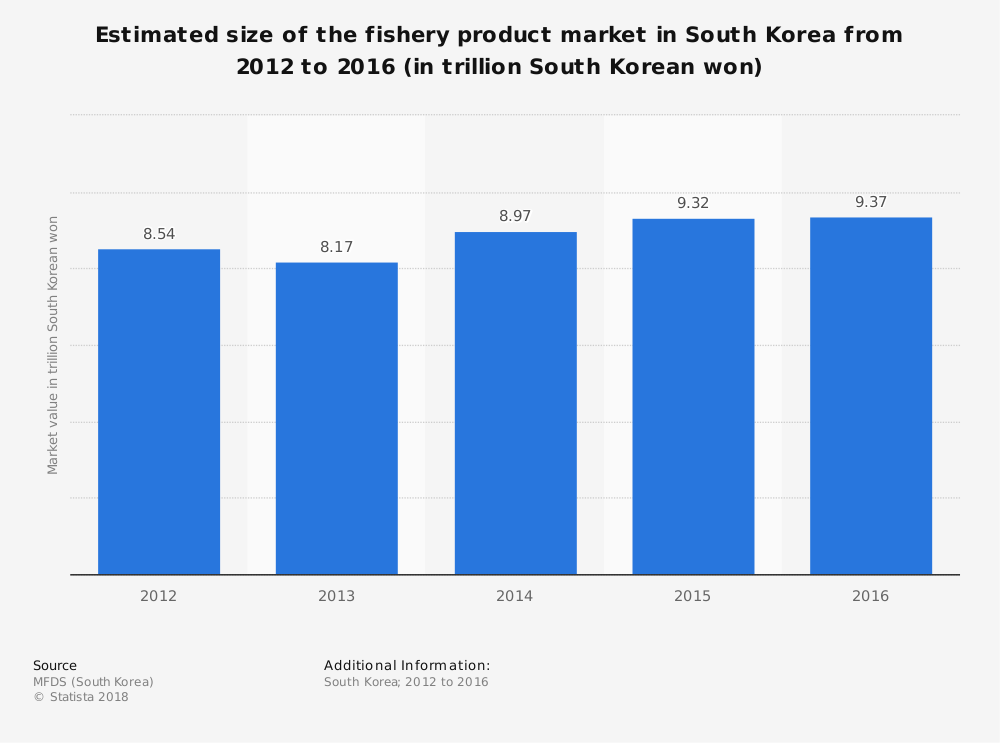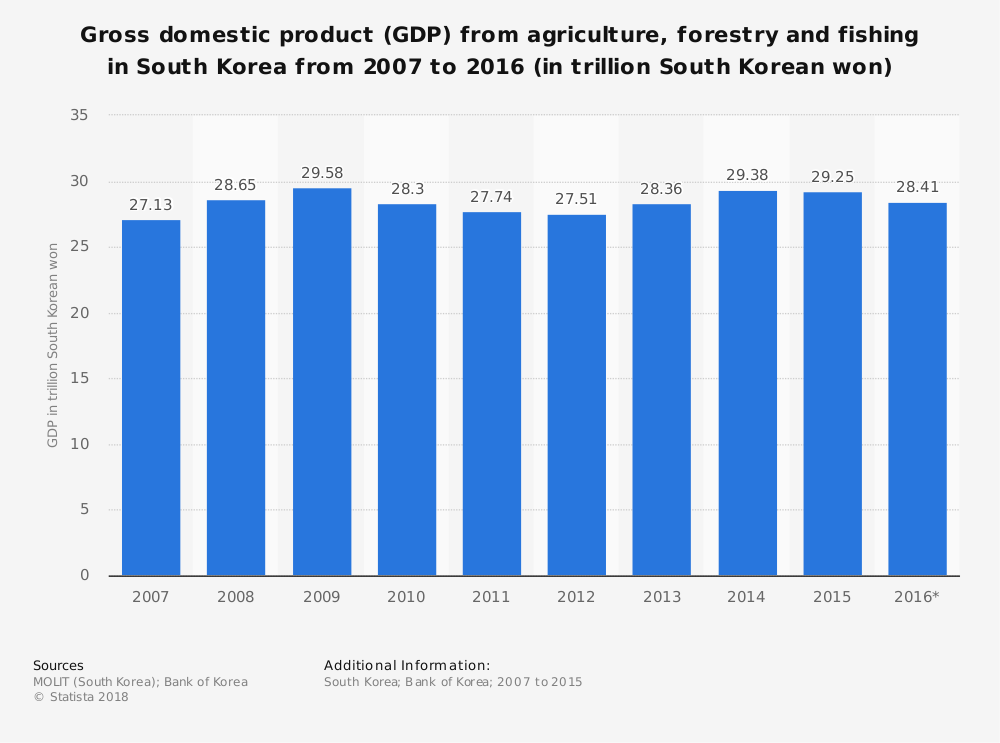After the conclusion of the Korean War and the establishment of South Korea, the fishing and agriculture industries were the primary economic generators for this new nation. Until the 1960s, fishing was such a top priority that South Koreans were often caught illegally fishing as far away as Africa.
The fishing industry in South Korea is not large or economically influential. In most years, fishing activities contribute less than 1% to the overall economy of the country. The importance of fishing to the culture, however, is much greater than the economic impact it creates. As far back as 2005, South Korea had the 6th-largest system of aquaculture production in the world.
What has affected the fishing industry since 1953 are the levels of inconsistency found in government policy. The South Korean government revised their fishery policies a total of 13 times through 1990, with the purpose to managing the industry as it grew.
Times, however, are changing. The fishing industry is growing in production still, while contracting in terms of employment. That has created several unique challenges for the industry to face.
Fascinating South Korean Fishing Industry Statistics
#1. In the fish and seafood industry, South Korea imported $4.5 billion of product in 2015, which was an increase of 18% from the year before. The fishing industry in South Korea imports fish and seafood products from over 100 countries, including China (25% share), Russia (16% share), and Vietnam (13% share). (Agriculture and Agri-Food Canada)
#2. Marine capture fisheries produced 1.84 million tons of output, accounting for 58% of the total produced by the South Korean fishing industry. (World Fishing and Aquaculture)

#3. Total fishery production by the South Korean fishing industry totaled 3.1 million tons in 2010, which was 2.1% of the global production rate. That ranked South Korea as the 12th-largest producer. (World Fishing and Aquaculture)
#4. Distant waters production by the industry totaled 612,000 tons, which represented one-third of the production from marine capture fisheries. (World Fishing and Aquaculture)
#5. The main species caught in distant waters fisheries are saury, tuna, squid, krill, and pollack. (World Fishing and Aquaculture)
#6. In the coastal and offshore fisheries production, the main species caught are croaker, squid, anchovies, clams, and blue crab. (World Fishing and Aquaculture)
#7. Over the past 30 years, aquaculture production for the South Korea fishing industry has doubled, accounting for 40% of total fishery production. At the same time, marine capture fisheries have seen their share of total production decline from 57% to 37%. (World Fishing and Aquaculture)
#8. The number of anglers involved with the South Korean fishing industry has been steadily declining since 1980. At the start of 2010, about 69,000 households were actively involved within the industry. In 1980, about 130,000 families were involved with the industry. (World Fishing and Aquaculture)
#9. In 2010, census figures show that 36% of the country’s anglers are 60 years of age or older. In 1995, just 25% of the anglers active with the fishing industry were in that age demographic. (World Fishing and Aquaculture)
#10. By 2020, the South Korean government estimates that up to 60% of the active anglers involved with fishing with be above the age of 60. (World Fishing and Aquaculture)

#11. Fish consumption in South Korea has grown by 57% in terms of weight over the past decade. The fishing industry is now responsible for about 40% of the average person’s annual protein intake in the country. (World Fishing and Aquaculture)
#12. Over 13,000 aquaculture licenses have been granted by the South Korean government to support the local fishing industry. Those licenses cover about 266,000 hectares of marine fisheries. (World Fishing and Aquaculture)
#13. Exports from the South Korean fishing industry were estimated to be worth $1.7 billion in 2012. (World Fishing and Aquaculture)
#14. Although aquaculture is an important part of the local fishing industry, 71% of the total production generated by aquaculture activities involves seaweed farming. Seaweed accounts for about 20% of the total reported aquaculture value. (FAO – United Nations)
#15. In 2015, the South Korean fishing fleet consisted of about 1,000 boats. 72% of the boats are classified as non-powered vessels. More than 90% of the fleet are less than 12 meters in length. Less than 1% of the fishing fleet, based in South Korea, is longer than 35 meters. (FAO – United Nations)
#16. In 2008, fisheries in South Korea contributed just 0.2% toward the country’s overall GDP. (FAO – United Nations)
#17. In total, the fishing industry in South Korea is responsible for the employment of over 106,000 people. About 35% of people employed by the industry are working in the aquaculture sector. (FAO – United Nations)
#18. 17.5% of the fish supply generated by the South Korean fishing industry is comprised of demersal fish. Pelagic fish account for another 13.9% of the annual catch. This is followed by mollusks (9.6%), cephalopods (6.7%), and crustaceans (3.4%). (FAO – United Nations)
#19. In 2014, consumers in South Korea spend a total of $7.8 billion on fish and seafood products. (Statista)
#20. In 2015, South Korea imported $233 million in fish and seafood products from the United States, which reflected an increase in value of 4.9% from the year before. Just 29 species account for over 90% of the imports sent from the U.S. to South Korea. The largest increase came from frozen lobster shipments, which were up 51% that year. (U.S. Department of Agriculture)
#21. Until 2000, the South Korean fishing industry was a net exported of seafood products. In 2015, however, the country exported $1.48 billion, while importing $2.76 billion in total value. (U.S. Department of Agriculture)
#22. The annual per capita consumption of seafood in South Korea is 53.8kg, although 17.4kg of that average figure comes from seaweed consumption. (U.S. Department of Agriculture)
South Korean Fishing Industry Trends and Analysis
Although the trends show that products from the fishing industry are quite popular in South Korea, there is not enough domestic production to satisfy demands. The rates of rice consumption continue to decline as the population transitions to a diet that is richer in proteins.
To counter this problem, South Korea has focused on creating an extensive system of aquaculture within the country. In November 2016, the Ministry of Oceans and Fisheries was able to report that 500 tons of salmon were successfully farmed for the first time. Their self-sufficiency rates have fallen sharply, however, in seafood, beef, and grain production, which has impacted the total value of the fishing industry in South Korea.
Despite the many challenges which face the industry today, it continues to be one of the world’s largest producers of seafood products. As the aquaculture environment continues to develop and grow, expect the South Korean fishing industry to continue developing strength in the coming years.
Although millions of people visit Brandon's blog each month, his path to success was not easy. Go here to read his incredible story, "From Disabled and $500k in Debt to a Pro Blogger with 5 Million Monthly Visitors." If you want to send Brandon a quick message, then visit his contact page here.
